If you were expecting some kind of sun sign nonsense, forget it. This is real astrology. See the section above. And if you need help deciphering the astrological glyphs in the graphics accompanying this article, see Astroglyphs: Astrological Symbols Guide. Please note: this forecast is expressed in terms of Universal Time (UT).
If the future road looms ominous or unpromising
then we need to gather our resolve
and step off into another direction.
--Maya Angelou
As much as 2003 was the year of Mars, 2004 will be the year of Venus. Mars signifies war, conflict, ambition, striving and avarice: these qualities were, as predicted, the indisputable hallmarks of 2003, from Gulf War II to the intefadas in Palestine and Iraq, to the nuclear posturing in North Korea (and to a lesser extent Iran). It was easy to call the martial theme in advance, looking at the way the Red Planet was so prominent in the heavens in 2003. The Mars super perigee and the several Mars oppositions to the outer planets were the prime celestial significators of 2003, clearly pointing to a martial agenda being paramount last year. This year, Mars fades into the background as surely as the Red Planet recedes into the distant heavens. For 2004, it's Venus that comes into prominence - and that sets an entirely different theme for the year.
Years with a prominent Mars, 2003 being a prime example, tend to have more than their share of fires and drought, hostility and strife. Mars is the root of the word martial, and the Red Planet has from ancient times been associated with war and all manner of violence. As much as strength and conflict characterize a big Mars year, peace and productivity are the hallmarks of a Venus year. I'm not saying the lion will lie down with the lamb, mind you. But the prominent Venus of 2004 suggests this will be a year more focused on creation than destruction, more concerned with finance and productivity than fighting and weaponry. No, peace won't break out all over in 2004. But we will see more of it than last year. And we should see an easing of drought that afflicted so many places in 2003 - and less risk of huge, out of control wildfires. Again, I'm not saying there'll be no fires or drought anywhere this year; only that there will be an over-all easing of these conditions in 2004 as compared to 2003.
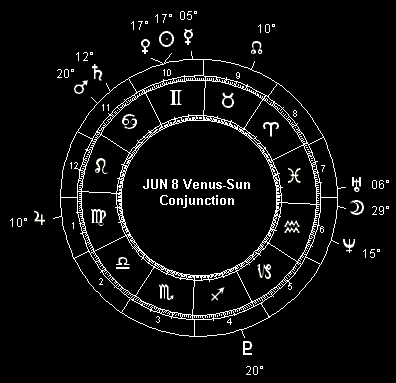 Venus makes one of its biennial retrogrades in 2004, which means it will pass between Earth and Sun. However this will be far different from an ordinary garden variety Venus intersolar period, when Venus and Earth are on the same side of the Sun. This time around, when Venus passes between Earth and Sun to form its inferior conjunction with Sol on June 8, the alignment between all three celestial bodies will be so precise that we on Earth will actually be able to see Venus passing across the face of the Sun. Venus goes intersolar, retrogrades and makes its inferior conjunction with the Sun every couple years or so. It starts with Venus' maximum eastern elongation (March 29 this year), intensifies at the retrograde station (May 17), peaks as Venus makes its inferior conjunction with the Sun (June 8), continues through the direct station (June 29), and finally draws to a close as Venus reaches maximum western elongation (August 17 this year). But a Venus transit across the solar disk is rare indeed: no one now alive has seen such a thing.
Venus makes one of its biennial retrogrades in 2004, which means it will pass between Earth and Sun. However this will be far different from an ordinary garden variety Venus intersolar period, when Venus and Earth are on the same side of the Sun. This time around, when Venus passes between Earth and Sun to form its inferior conjunction with Sol on June 8, the alignment between all three celestial bodies will be so precise that we on Earth will actually be able to see Venus passing across the face of the Sun. Venus goes intersolar, retrogrades and makes its inferior conjunction with the Sun every couple years or so. It starts with Venus' maximum eastern elongation (March 29 this year), intensifies at the retrograde station (May 17), peaks as Venus makes its inferior conjunction with the Sun (June 8), continues through the direct station (June 29), and finally draws to a close as Venus reaches maximum western elongation (August 17 this year). But a Venus transit across the solar disk is rare indeed: no one now alive has seen such a thing.
The last time Venus transited the Sun was back in 1882, on December 6 at 15 Sagittarius. This year's transit occurs at 18 Gemini. All Venus-Sun transits over the last 1900+ years have taken place either in Gemini or in Sagittarius, where the north and south nodes (respectively) of Venus are located during this epoch of history. The last transit in the preceding Taurus-Scorpio polarity occurred in the year 60 CE (Common Era, equivalent to AD), and the current Gemini-Sagittarius transits will continue for 1500 years or so. The 2004 Venus transit belongs to Transit Series 3 (analogous to the Saros Series in eclipses), and is the first in this series since Venus transited over the Sun at 16 Gemini on June 6, 1761. It will be followed in 2012 by a transit at 16 Gemini on June 6, belonging to Transit Series 5. (The last transit in this Series occurred on June 3, 1769 at 13 Gemini.)
Astrology aficionados will no doubt recognize the middle Gemini-Sagittarius region of all these Venus transits: it's the horizon in the only contemporary horoscope for the US Declaration of Independence (namely, the so-called Sibly chart, which features 13 Sagittarius on the ascendant). Having the 2004 Venus solar transit conjunct Mars in the seventh house of the national horoscope is a most auspicious and favorable indicator for the USA, suggesting successful military campaigns, better relations with allies, and improvement in the nation's economy and financial system. Some years it seems nothing goes right. This year, for Uncle Sam, more than a few things turn out okay in the end - especially around mid-year, close to the actual date of the alignment.
While the Venus transit across the Sun bodes well for the world as a whole this year, it's especially promising for nations (such as the USA) and people born under significant middle Gemini-Sagittarius factors. This includes lots of people born in early June and December of any year, for example. But it's hardly limited in that respect, because there are many dates through the years that feature important middle Gemini-Sagittarius lunar or planetary factors. For example, President Bush was born with Uranus and the Moon's north node in this zone: there's a lucky break. Canada likewise: the 1867 British North America Act chart features Venus at 16 Gemini, which suggests a very positive year for the Canadian economy. (Not sure how the Venus transit might apply to you? Check your chart!)
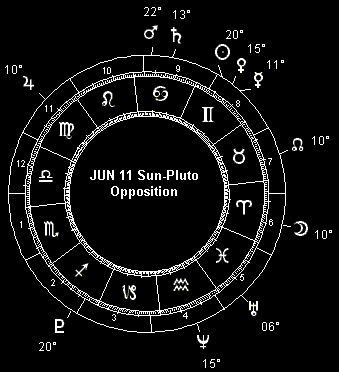 It's important to note that this year's Venus transit over the Sun is in opposition to Pluto. This means that any economic upturn associated with the Earth-Venus-Sun alignment is fragile rather than robust - the kind of thing that could run for months or even a year or so, but not a whole lot longer. Excessive debt and insufficient capital reserves could end up choking off the boom by late 2005 or early 2006, when the Moon's declination peak comes along. Don't mistake a temporary boomlet for more than what it is.
It's important to note that this year's Venus transit over the Sun is in opposition to Pluto. This means that any economic upturn associated with the Earth-Venus-Sun alignment is fragile rather than robust - the kind of thing that could run for months or even a year or so, but not a whole lot longer. Excessive debt and insufficient capital reserves could end up choking off the boom by late 2005 or early 2006, when the Moon's declination peak comes along. Don't mistake a temporary boomlet for more than what it is.
I know, I know: this isn't a fashionable forecast. The Cassandra complex is quite strong enough in the general public (let alone some astrologers), that it's always more newsworthy to predict gloom and doom and catastrophe than relative peace and general good fortune. Regular readers of my forecasts know full well that when other prognosticators were warning of imminent apocalypse over the years, I was calling it right. While 2004 will have its share of tragedies - and I'll get to those shortly - the fact is that this one rare and wonderful Venus alignment with Earth and Sun promises more good than ill, more peace than war, more prosperity than poverty. It won't be nirvana, but it will be a long way from Armageddon. Deal with it.
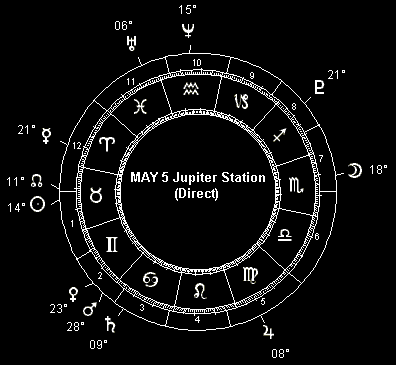 For the first time in years, there are no major outer planet alignments in the coming twelve months. By this, I mean there isn't a single conjunction or opposition of a planet outside the orbit of Mars with another planet outside the orbit of Mars. The closest we come to such an alignment is when Jupiter stations within three degrees of opposing Uranus on May 5, from 9 Virgo to 6 Pisces. But the exact alignment of these two planets happened last year, and this near miss looks like a faint shadow of the original. And that's just as well, because Jupiter opposing Uranus tends to coincide with ideological conflict and attempts at repression. Also another run-up in the gold market, which began as forecast with the Jupiter transit into Leo last year and continues until the Jupiter Libra ingress in September 2004. (The Jupiter-Uranus opposition seems to coincide with an acceleration in this upward trend.) Unfortunately, this alignment also shows some correlation with public health scares - or worse. So the specter of people wearing surgical masks and domestic animals being slaughtered to prevent disease will continue into 2004, probably peaking around early May with a second spike in the fall.
For the first time in years, there are no major outer planet alignments in the coming twelve months. By this, I mean there isn't a single conjunction or opposition of a planet outside the orbit of Mars with another planet outside the orbit of Mars. The closest we come to such an alignment is when Jupiter stations within three degrees of opposing Uranus on May 5, from 9 Virgo to 6 Pisces. But the exact alignment of these two planets happened last year, and this near miss looks like a faint shadow of the original. And that's just as well, because Jupiter opposing Uranus tends to coincide with ideological conflict and attempts at repression. Also another run-up in the gold market, which began as forecast with the Jupiter transit into Leo last year and continues until the Jupiter Libra ingress in September 2004. (The Jupiter-Uranus opposition seems to coincide with an acceleration in this upward trend.) Unfortunately, this alignment also shows some correlation with public health scares - or worse. So the specter of people wearing surgical masks and domestic animals being slaughtered to prevent disease will continue into 2004, probably peaking around early May with a second spike in the fall.
This near reprise of the Jupiter-Uranus alignment aside, the lack of major planet alignments suggests that 2004 will be a year of relative calm, a time for reflection and consolidation rather than the kind of headlong rush to action that characterized 2003 - and indeed, all of the last few years. If I'm right, then we're coming into what amounts to a time for catching our breath, figuring out where we're at and how we got there - and how to reconcile and consolidate all we've encountered and caused lately.
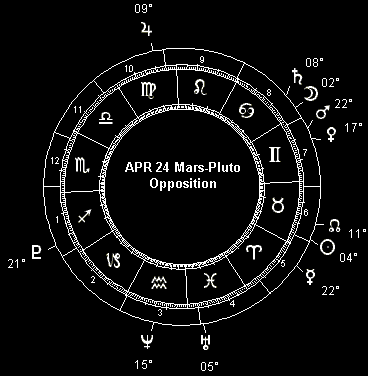 Don't get me wrong, I'm not saying 2004 will be a snoozer. The year's strong Mars aspects - and there are more than a few - attest that peace and quiet won't break out worldwide in 2004. But these martial signs are mere shadows of those in 2003 and 2001. By comparison, the strong Mars factors in 2003 spoke of violence on a collective scale - wholesale conflict, so to speak. The 2004 Mars signals are on a smaller, more individual scale. With only a few possible exceptions, mostly earlier in the year, they point more to murder than to war, for example; more to robbery than to invasion. These are fires, in other words - not whole conflagrations. The exceptions, which may coincide with terror attacks (and counter-attacks), are most likely around the time that Mars comes to the degree of the November 9, 2003 lunar eclipse on February 28, 2004, and opposes the December 23 solar eclipse degree on March 23. A couple more suspicious intervals come a few days either way of the Mars oppositions to Pluto on April 24, Neptune on July 16, and Uranus on August 18. These are times of danger, to be sure - and they may be tragic. But they don't threaten the world order to the extent that Gulf War II did in 2003.
Don't get me wrong, I'm not saying 2004 will be a snoozer. The year's strong Mars aspects - and there are more than a few - attest that peace and quiet won't break out worldwide in 2004. But these martial signs are mere shadows of those in 2003 and 2001. By comparison, the strong Mars factors in 2003 spoke of violence on a collective scale - wholesale conflict, so to speak. The 2004 Mars signals are on a smaller, more individual scale. With only a few possible exceptions, mostly earlier in the year, they point more to murder than to war, for example; more to robbery than to invasion. These are fires, in other words - not whole conflagrations. The exceptions, which may coincide with terror attacks (and counter-attacks), are most likely around the time that Mars comes to the degree of the November 9, 2003 lunar eclipse on February 28, 2004, and opposes the December 23 solar eclipse degree on March 23. A couple more suspicious intervals come a few days either way of the Mars oppositions to Pluto on April 24, Neptune on July 16, and Uranus on August 18. These are times of danger, to be sure - and they may be tragic. But they don't threaten the world order to the extent that Gulf War II did in 2003.
The crucial difference between this year and last is revealed by the Sun-Mars conjunction on September 15 at 23 Virgo: unlike 2003, the Red Planet spends most of 2004 at the opposite side of the solar system from Earth. You may as well expect fires and crashes and bombs and violent crime or even terror attacks to make headlines around the dates mentioned above. But somehow they won't seem to shake up the world order like the events associated with 2003's much more potent Mars factors. And this is even more the case with the Red Planet factors later in the year, starting with the Mars-Jupiter alignment on September 27. This is followed on October 28, the day of the second total lunar eclipse of 2004, when Mars comes to the degree of the solar eclipse on the 14th of that month. November has a couple of strong Mars activations as well: on the 10th, Mars opposes the April 19 solar eclipse degree; while on the 18th Mars reaches the opposition point to the October 28 eclipse. And finally, on December 3 the Red Planet comes to the degree of the May 4 lunar eclipse.
 Including its legendary retrogrades, Mercury's intersolar periods always bear watching. They occur when Mercury and the Earth are on the same side of the Sun, beginning at Mercury's maximum eastern elongation, continuing through the Mercury retrograde, culminating at Mercury's inferior conjunction with the Sun, and finally ending when Mercury reaches maximum western elongation. For 2004, Mercury's intersolar cycles are January 1 - 17 (a leftover from 2003), March 29 to May 14, July 27 to September 9, and November 21 to December 29. Mark these dates on your calendar: they're the silly seasons of 2004, the times when Murphy's Law runs amok, when everything that can go wrong probably will. Dropped connections, missed and misunderstood messages, things that get lost, hacker attacks, clever cons and sneak thieves, and infrastructure breakdowns due to human error, neglect or even malice: these and all similar perils are plentiful during Mercury's intersolar phase. Double-check and follow up on everything during these cycles, take nothing for granted. Paperwork, communication, transport and networks of all kinds are key vulnerabilities at such times. To the extent that these things are important to you during Mercury's intersolar transit, it will behoove you to have a backup plan in place, a fallback position ready during these periods. On the plus side, these times are good for going back and fixing up stuff you thought was over and done with, or wrapping up unfinished business. (Heaven knows, there'll be plenty to work with in these areas at times like this.)
Including its legendary retrogrades, Mercury's intersolar periods always bear watching. They occur when Mercury and the Earth are on the same side of the Sun, beginning at Mercury's maximum eastern elongation, continuing through the Mercury retrograde, culminating at Mercury's inferior conjunction with the Sun, and finally ending when Mercury reaches maximum western elongation. For 2004, Mercury's intersolar cycles are January 1 - 17 (a leftover from 2003), March 29 to May 14, July 27 to September 9, and November 21 to December 29. Mark these dates on your calendar: they're the silly seasons of 2004, the times when Murphy's Law runs amok, when everything that can go wrong probably will. Dropped connections, missed and misunderstood messages, things that get lost, hacker attacks, clever cons and sneak thieves, and infrastructure breakdowns due to human error, neglect or even malice: these and all similar perils are plentiful during Mercury's intersolar phase. Double-check and follow up on everything during these cycles, take nothing for granted. Paperwork, communication, transport and networks of all kinds are key vulnerabilities at such times. To the extent that these things are important to you during Mercury's intersolar transit, it will behoove you to have a backup plan in place, a fallback position ready during these periods. On the plus side, these times are good for going back and fixing up stuff you thought was over and done with, or wrapping up unfinished business. (Heaven knows, there'll be plenty to work with in these areas at times like this.)
As always, the eclipses and SuperMoons of 2004 are suggestive of important trends and periods during the year. This is another remarkable year in that regard: 2003-2004 is one of only eight two-year periods in the 21st Century that together feature a total of four consecutive total lunar eclipses. This year is a reprise of last year's Taurus-Scorpio eclipse sign polarities, but it introduces an Aries-Libra polarity in place of 2003's Gemini-Sagittarius axis. There are only three SuperMoons this year, and for the first time in a couple years there's not a single SuperMoon eclipse. (SuperMoon is a term I coined in a 1979 article for Dell HOROSCOPE magazine, referring to perigee-syzygy: a new or full moon [syzygy] that occurs at or near the closest point [perigee] in the Moon's orbit around the Earth.)
All three 2004 SuperMoons occur with the Moon at or near its greatest southern declination; which is to say, as far south of the equator as Luna gets in its monthly cycle. In contrast, this year's eclipses all happen within a day or two of Luna crossing the celestial equator. Having all these key lunations for the year at or near significant points in the lunar declination cycle suggests that 2004 will have more than its share of geophysical disturbances. This will manifest as unusually high tides, strong storms with high winds and heavy precipitation (in some cases causing floods or mudslides), and moderate to severe seismic activity (including Richter 5+ earthquakes and volcanic eruptions). Some years are relatively quiet, as natural disasters go - 2004 won't be one of them, but it won't be one of the very worst either (despite ranking at the higher rather than lower end of that scale).
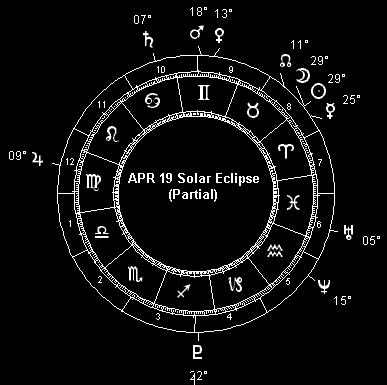 While these tides in the seas, crust and atmosphere of our home planet will tend to be most extreme within a few days before and after the SuperMoons and eclipses of 2004, there will be plenty of geophysical disturbances at other times during the year. The Moon is nearing its extreme declination maxima, topping 28 degrees north declination a couple times this year. (The peak in the current declination cycle comes in late 2005 and early 2006: times to watch both for a peak in geophysical disturbances and for a 1987-style equities crash, I suspect.)
While these tides in the seas, crust and atmosphere of our home planet will tend to be most extreme within a few days before and after the SuperMoons and eclipses of 2004, there will be plenty of geophysical disturbances at other times during the year. The Moon is nearing its extreme declination maxima, topping 28 degrees north declination a couple times this year. (The peak in the current declination cycle comes in late 2005 and early 2006: times to watch both for a peak in geophysical disturbances and for a 1987-style equities crash, I suspect.)
The first eclipse of the year is the April 19 partial solar eclipse in the last degree of Aries, belonging to Saros Series 119. This is an old series that began on May 15, 850 and concludes on June 24, 2112. Saros Series 119 entered its concluding run of partial eclipses back in 1968 (on March 28). This year's April 19 event is only the third in that final sequence. (The previous partial eclipse in this series occurred on April 9, 1986. The last central eclipse of the series was on March 18, 1950.) Being a solar eclipse, the weather and seismic nuances of the April 19 lunation will be felt from the 2nd through the 16th. Severe windstorms look like a specialty of this eclipse, which also shows signs of ushering in high fire hazard conditions. And of course the potential for moderate to severe earthquakes and volcanic eruptions will be high during this period.
Being planetary in scale, there's no place on Earth beyond the reach of natural calamity during the April 19 eclipse window. Of course there are regions where earthquakes are common hazards, and volcanoes are where you find them. Anyone living in seismic risk zones of this sort would do well to have emergency preparations made and ready every day - and especially around the period from a week before to a week after the April 19 eclipse. Known hazardous geography of this sort aside, there are some hints as to areas of special risk during the April partial eclipse. There is, for example, the eclipse's zone of visibility - mainly southern Africa. And there are astro-locality hints has well, suggesting a heightened storm and seismic risk along the Pacific coast of North America (with severe storm warnings through the Midwest and eastern Dixie, as well as near Caracas and southwest of Rio de Janeiro; on a southerly line from Iceland down through the Atlantic; plus the whole of the Middle East and along a northeasterly arc through Delhi and into western China. Just don't get blasé if you're not in one of these zones during the April 12-26 risk window. Have your foul weather backup plans ready, your emergency kit stocked, and allow for weather-related delays if you're traveling at the time.
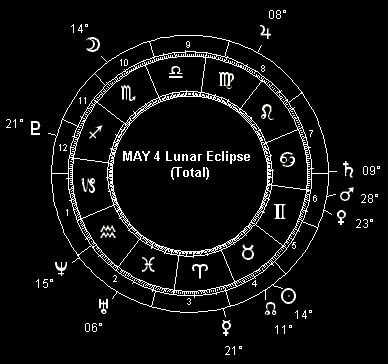 The total lunar eclipse at 15 Scorpio on May 4 belongs to Saros Series 131, which began on May 10, 1427 (near the turning point of the Hundred Years War, which ended England's continental expansionism). Series 131 first went total on April 2, 1950 (on the eve of the Korean War, the first major outbreak in the Cold War). While I suspect that world finance, economic institutions and public health will be the focus of attention around this time, this eclipse still points to an upsurge in strong storms with heavy precipitation and high winds during the May 1 - 7 time frame. Look for an up-tick in moderate to severe seismic activity as well, including Richter 5+ quakes and volcanic eruptions. And be prepared for such eventualities, including having your home emergency kit ready; and, if traveling or expecting someone who is, plan on weather-related delays playing havoc with the itinerary.
The total lunar eclipse at 15 Scorpio on May 4 belongs to Saros Series 131, which began on May 10, 1427 (near the turning point of the Hundred Years War, which ended England's continental expansionism). Series 131 first went total on April 2, 1950 (on the eve of the Korean War, the first major outbreak in the Cold War). While I suspect that world finance, economic institutions and public health will be the focus of attention around this time, this eclipse still points to an upsurge in strong storms with heavy precipitation and high winds during the May 1 - 7 time frame. Look for an up-tick in moderate to severe seismic activity as well, including Richter 5+ quakes and volcanic eruptions. And be prepared for such eventualities, including having your home emergency kit ready; and, if traveling or expecting someone who is, plan on weather-related delays playing havoc with the itinerary.
Of course, seismically active regions are at special risk during this period. But severe weather can strike anywhere at all, so no one should feel complacent in that regard. Still, astro-locality suggests a few areas which are perhaps of greatest vulnerability to elevated meteorological as well as seismic risk during the May 1 - 7 time frame. Among these is northwestern North America (particularly the Pacific coast of Canada), as well as along a pair of north-south lines running through Havana in the west and Boston in the east. The Atlantic coast of South America from Brazil southward is part of another risk vector, the other end of which swings down through China and across eastern Australia. East Africa, the Middle East and much of Russia lie in another risk zone, which runs along a north-south line passing through Tehran. And finally, there's another pair of north-south lines bracketing Indochina from east to west, extending northward into China and southward across Indonesia.
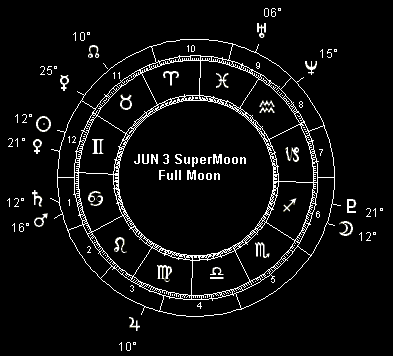 The year's first SuperMoon occurs at 13 Sagittarius on June 3 when the moon is full and near its monthly south declination maximum, while Mars is aligned with Saturn in the early evening sky. Severe storms with dangerous wind and lightning plus heavy precipitation are the stuff of headlines May 30 - June 6; as well as powerful earthquakes (Richter 5 or greater) and possibly volcanic eruptions too. Heavy precipitation and high tides make for flooding inland and along the coasts. Insurance companies will look back on this period and wince. There's no place on Earth out of range for a planetary phenomenon like this, but astro-locality suggests a few zones which are possibly more vulnerable than most. One of these lies along a north-south line through San Juan, Puerto Rico; another north-south line halfway 'round the world matches this one, running from Shanghai down through Perth. Shifted slightly east of this pair is another couple of risk zones, running from the easternmost Brazilian coast up through Greenland in the west and from Melbourne and Sydney northward through Port Moresby and beyond in the east.
The year's first SuperMoon occurs at 13 Sagittarius on June 3 when the moon is full and near its monthly south declination maximum, while Mars is aligned with Saturn in the early evening sky. Severe storms with dangerous wind and lightning plus heavy precipitation are the stuff of headlines May 30 - June 6; as well as powerful earthquakes (Richter 5 or greater) and possibly volcanic eruptions too. Heavy precipitation and high tides make for flooding inland and along the coasts. Insurance companies will look back on this period and wince. There's no place on Earth out of range for a planetary phenomenon like this, but astro-locality suggests a few zones which are possibly more vulnerable than most. One of these lies along a north-south line through San Juan, Puerto Rico; another north-south line halfway 'round the world matches this one, running from Shanghai down through Perth. Shifted slightly east of this pair is another couple of risk zones, running from the easternmost Brazilian coast up through Greenland in the west and from Melbourne and Sydney northward through Port Moresby and beyond in the east.
In addition, there are two distinct arcs of geophysical vulnerability during the May 30 - June 6 SuperMoon risk window, wrapping 'round the globe. One goes from the Pacific Northwest through Alberta, curving across through Greenland, southern England and France, across the Mediterranean through Algeria and from there southeasterly across Africa through Zimbabwe. The other end of this same arc then passes just east of New Zealand. The second arc cuts through northern Mexico and across the Plains States through Ontario, across the southern tip of Greenland and the north of Iceland, and from there across Scandinavia, down through eastern Europe and southeasterly across the Arabian Peninsula.
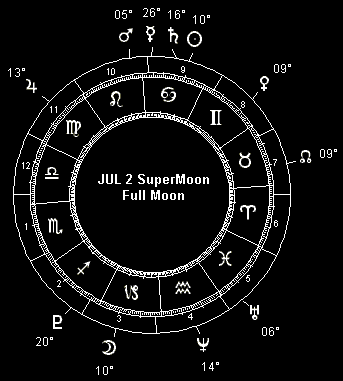 The July 2 SuperMoon is another full moon, this time at 11 Capricorn and only hours after the monthly lunar south declination maximum. Mudslides and other forms of flooding - including coastal floods due to storm driven high tides - look like a specialty of this SuperMoon, during the June 29 - July 5 risk window. Of course this means a spike in moderate to severe seismic activity, from Richter 5+ quakes to volcanic eruptions. It also points to powerful storms with strong winds and heavy precipitation. Homes, farms, ranches and mining operations may be especially vulnerable this time around. And, as with last month's SuperMoon, insurance companies will be hard hit by this one. As always, there's no place on Earth beyond the reach of a planetary scale alignment such as this. That said, astro-locality analysis puts Alaska, the Yukon and British Columbia in the crosshairs, along with Central America and the Pacific coast of South America plus Argentina. (The US heartland and the entire Gulf of Mexico also appear vulnerable to powerful storms at this time.) Across the Atlantic, there's a north-south danger zone bounded by Rome in the west and Stockholm in the east, running out through the southeast tip of Africa. The other major risk zone lies within a northeasterly arc stretching from Indonesia and the west coast of Australia, through Singapore and the southeastern tip of Indochina, along the Chinese coast, through Vladivostok and bracketing Japan on either side.
The July 2 SuperMoon is another full moon, this time at 11 Capricorn and only hours after the monthly lunar south declination maximum. Mudslides and other forms of flooding - including coastal floods due to storm driven high tides - look like a specialty of this SuperMoon, during the June 29 - July 5 risk window. Of course this means a spike in moderate to severe seismic activity, from Richter 5+ quakes to volcanic eruptions. It also points to powerful storms with strong winds and heavy precipitation. Homes, farms, ranches and mining operations may be especially vulnerable this time around. And, as with last month's SuperMoon, insurance companies will be hard hit by this one. As always, there's no place on Earth beyond the reach of a planetary scale alignment such as this. That said, astro-locality analysis puts Alaska, the Yukon and British Columbia in the crosshairs, along with Central America and the Pacific coast of South America plus Argentina. (The US heartland and the entire Gulf of Mexico also appear vulnerable to powerful storms at this time.) Across the Atlantic, there's a north-south danger zone bounded by Rome in the west and Stockholm in the east, running out through the southeast tip of Africa. The other major risk zone lies within a northeasterly arc stretching from Indonesia and the west coast of Australia, through Singapore and the southeastern tip of Indochina, along the Chinese coast, through Vladivostok and bracketing Japan on either side.
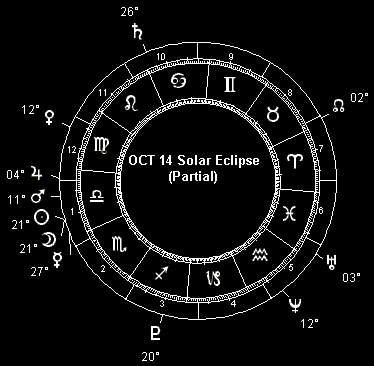 The October 14 partial solar eclipse at 21 Libra belongs to Saros Series 124, which began on March 6, 1049, when there was a plague among English cattle and "a great mortality among men," according to the Anglo-Saxon chronicle. This series concludes on May 11, 2347. The October 14 event marks the beginning of the concluding partial sequence for this Saros Series. The last central eclipse in this series occurred on October 3, 1986 - the year the first reports of mad cow disease surfaced in England. The historic link between this Saros Series and cattle disease does not bode well as far as the 2003 US and Canadian mad cow outbreak is concerned. If anything, it suggests that this story has far from run its course; that the isolated cases in Alberta and Washington are just the 'tip of the iceberg,' so to speak.
The October 14 partial solar eclipse at 21 Libra belongs to Saros Series 124, which began on March 6, 1049, when there was a plague among English cattle and "a great mortality among men," according to the Anglo-Saxon chronicle. This series concludes on May 11, 2347. The October 14 event marks the beginning of the concluding partial sequence for this Saros Series. The last central eclipse in this series occurred on October 3, 1986 - the year the first reports of mad cow disease surfaced in England. The historic link between this Saros Series and cattle disease does not bode well as far as the 2003 US and Canadian mad cow outbreak is concerned. If anything, it suggests that this story has far from run its course; that the isolated cases in Alberta and Washington are just the 'tip of the iceberg,' so to speak.
Being a solar eclipse, this one comes with a geophysical risk window that extends seven days before and after the actual event. So be on the alert for strong storms with high winds and heavy precipitation between October 7 and 21. Figure on weather-related delays slowing down people and goods in transit, and have your candles and bottled water ready just in case. If you're in (or plan to be in) a seismically vulnerable locale during this period, be ready for an increase in moderate to severe earthquake activity (Richter 5 and up). Watch for all this stuff in the headlines, and a volcanic eruption or two as well.
While global in scope, the kind of seismic and meteorological action associated with this eclipse is especially likely in its zone of visibility: northeastern Asia, Alaska, and parts of the northern Pacific Ocean (including Hawaii). In addition, astro-locality mapping points to vulnerable zones including eastern South America in the western hemisphere, plus Japan and New Guinea in the eastern hemisphere; also along a northeasterly arc from the Horn of Africa through the Arabian Peninsula into Iran and Russia.
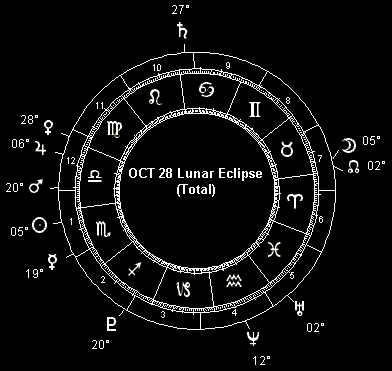 The total lunar eclipse at 5 Taurus on October 28 belongs to Saros Series 136, which began on April 13, 1680 (the year of the Cas-A supernova, and the start of two decades of 'global cooling'). This series entered its total sequence on September 26, 1950 - another tie to the Korean War, one of several such historical parallels among the eclipses of 2004. Certainly, we can expect headlines focusing on accounts of Mother Nature gone wild during the October 25-31 eclipse window: severe storms with high winds and heavy precipitation (possibly causing local flooding and mudslides), as well as Richter 5+ earthquakes and volcanoes in seismic hot spots.
The total lunar eclipse at 5 Taurus on October 28 belongs to Saros Series 136, which began on April 13, 1680 (the year of the Cas-A supernova, and the start of two decades of 'global cooling'). This series entered its total sequence on September 26, 1950 - another tie to the Korean War, one of several such historical parallels among the eclipses of 2004. Certainly, we can expect headlines focusing on accounts of Mother Nature gone wild during the October 25-31 eclipse window: severe storms with high winds and heavy precipitation (possibly causing local flooding and mudslides), as well as Richter 5+ earthquakes and volcanoes in seismic hot spots.
Geocosmic alignments like the October 28 eclipse are planetary in scale, so there's no place on Earth beyond the reach of the kind of natural disasters associated with this phenomenon. Therefore, no matter where you'll be between the 25th and 31st of October, you'll do well to have a foul weather contingency already planned out, and your emergency kit handy. Still, some places look more vulnerable than others. Looking at the astro-locality map for this eclipse, Hawaii, western Alaska and the Aleutian Islands are in sensitive spots, along with the New York City area and the eastern Caribbean. There's also a hot zone running along a north-south line from the southwest coast of Greenland down through Brasilia, and a similar line just west of that running from just east of San Juan, Puerto Rico (and all points due south) north through Nova Scotia. The entire eastern half of Africa, from Capetown to Cairo, is laced with several hot zones that reach up into Turkey and Russia (on an arc from the Black Sea to Moscow), as well as the Middle East (including Israel, Saudi Arabia, Iraq and Iran) and points northeast along an arc through the Caspian Sea. Eastern Russia and the Korean peninsula (along the longitude of Yakutsk) and eastern China (along the longitude of Beijing) stake out another north-south danger zone that stretches down into the Philippines, Indonesia and western Australia. And finally, Japan from Tokyo northward is part of a zone which, at these latitudes, appears to suggest infrastructure breakdowns due to natural phenomena - earthquakes or storms are obvious candidates, but this could also be associated with a geomagnetic disturbance.
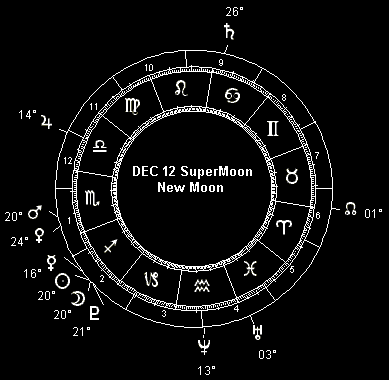 The December 12 SuperMoon at 20 Sagittarius is the last new moon of the year, and happens less than 24 hours before the Moon's monthly maximum declination south of the celestial equator. This is a potent alignment, indicating a strong surge in dangerous storms, floods, earthquakes and volcanic eruptions. Wherever you live, be ready for this one. Have your bottled water, batteries and candles ready, your emergency kit handy, your foul weather gear checked out and ready. Chances are, most of us won't need stuff like this during the December 9 - 15 SuperMoon risk window. But those who do will thank their lucky stars they were prepared. With a geocosmic alignment like this in effect, the whole of Planet Earth falls under its sway. That's exactly why everyone should be prepared just in case. But it's also the reason most of us will escape unscathed: it's a big planet, and catastrophes are more often than not localized.
The December 12 SuperMoon at 20 Sagittarius is the last new moon of the year, and happens less than 24 hours before the Moon's monthly maximum declination south of the celestial equator. This is a potent alignment, indicating a strong surge in dangerous storms, floods, earthquakes and volcanic eruptions. Wherever you live, be ready for this one. Have your bottled water, batteries and candles ready, your emergency kit handy, your foul weather gear checked out and ready. Chances are, most of us won't need stuff like this during the December 9 - 15 SuperMoon risk window. But those who do will thank their lucky stars they were prepared. With a geocosmic alignment like this in effect, the whole of Planet Earth falls under its sway. That's exactly why everyone should be prepared just in case. But it's also the reason most of us will escape unscathed: it's a big planet, and catastrophes are more often than not localized.
Astro-locality analysis does suggest a few zones which may be particularly at risk during this SuperMoon period. Western Alaska, the Aleutian Islands and Hawaii are part of one danger zone, which arcs across vast stretches of open ocean to touch all of western coastal Africa (and inland a few hundred miles), and goes from there across the Middle East into Russia. Another lies along an arc stretching from Barrow, Alaska across the Great Plains from Alberta on into the Mississippi River system through New Orleans out into the Gulf of Mexico, across the western tip of Cuba and through Panama into northwestern South America and out through the southeastern coast of the continent (near Buenos Aires). Another risk zone runs north-south through Iceland, otherwise mostly over open ocean. Its mirror image is on the opposite side of the world, running north-south very near the longitude of Brisbane, Australia. Another north-south zone goes pole to pole through Prague (touching Rome, Tripoli and Kinshasa along the way). And finally, there's an arc of potential danger stretching from Bombay through Delhi and across western China into Russia (passing near Yakutsk) and out across the Bering Strait.
Turning from the caprices of Mother Nature to the contortions of the body politic, this year's US elections will be closely watched the world over. President Bush's reelection, which seemed so certain just a couple years ago, is far from guaranteed. It was a fairly easy matter to compare the two contenders in 2000, and evaluate the result in advance: "George W. Bush's chart has better transits than Al Gore's at election time," is how I put it in my 2000 Forecast Highlights a year in advance of the election. (Transits to a natal chart, in case you're unacquainted with astrological jargon, refers to planet positions at some point in time after birth, as compared to planet positions at the moment of birth.)
The Bush win, as convoluted and controversial as it was, dovetailed nicely with the transits to the natal horoscopes of the two major party candidates at election time. It wasn't so much a case of George Bush having wonderful transits then, as it was a case of Al Gore's transits suggesting a huge disappointment for the Democratic contender. Namely, Saturn out in space on Election Day 2000 was right where Venus was when Gore was born. This happens only every 30 years or so, which makes it a significant long term cycle. And it tends to indicate a bitter disappointment. In his long political life, Vice President Gore had few major career setbacks. But he was primed for one in November 2000.
Lacking any similarly discouraging transits then, the Bush chart was obviously far more favorably disposed as America went to the polls in 2000. In fact, the Republican nominee had a mildly favorable transit, as the Moon's north node closed in on the position of the Sun when Bush was born. This too is a significant long term cycle, occurring only once every 19 years or so.
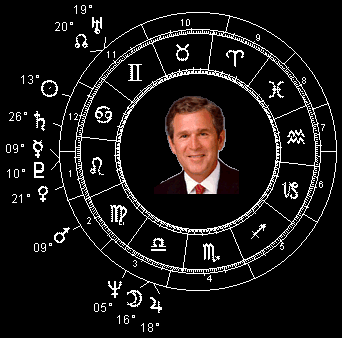 President Bush's standing in the public opinion polls soared as Iraq crumbled and collapsed in Gulf War II - a war that I predicted back in October 2002, when I wrote that "a big offensive modeled after the Persian Gulf War" would come in 2003. My 2003 Forecast Highlights plainly foretold a clash between the US and Iraq: "a conflict between these two countries going critical early in the year: an attack, an assassination attempt, civilians and soldiers in harm's way, the whole martial mess."
President Bush's standing in the public opinion polls soared as Iraq crumbled and collapsed in Gulf War II - a war that I predicted back in October 2002, when I wrote that "a big offensive modeled after the Persian Gulf War" would come in 2003. My 2003 Forecast Highlights plainly foretold a clash between the US and Iraq: "a conflict between these two countries going critical early in the year: an attack, an assassination attempt, civilians and soldiers in harm's way, the whole martial mess."
For a couple months after Baghdad fell and Saddam Hussein went into hiding, President Bush's approval rating stood in the 70% range. But when Saturn entered Cancer in June of 2003, the President's standing in the polls went into decline. This is a bad sign for the President, for Saturn will still be in Cancer come the 2004 election. In fact, the Ringed Planet will be right where it was when Bush was born, for only the second time in his life. (Astrologers call this the second Saturn return.) Going into what could be a career-ending all-or-nothing struggle under a Saturn return, President Bush is in the political fight of his life - and in real danger of losing.
George W. Bush has so far stood for election four times in his life, and lost only once. That was his first time out, a run for Congress in 1978. It was the only time until 2004 that he went to the polls with transiting Saturn lined up right on one of his natal planets. In the 1978 election, transiting Saturn was less than three degrees from Bush's natal Mars. This time around, Saturn will be less than a degree from its place in his birth chart. All else being equal, unless he goes up against an opponent with equally dismal transits, the incumbent has less than even odds of winning reelection.
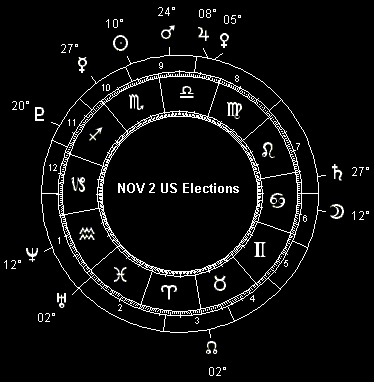 There's good news and there's bad news for Mr. Bush and the Republicans in 2004. On Election Day, Saturn being in Cancer is in the sign of its traditional detriment; which means it is weakly placed. Saturn being the planet associated with the Democratic Party, this does not bode well for the Democrats. Worse yet for the Democrats is Jupiter's conjunction with Venus on Election Day. This is traditionally an excellent placement for Jupiter, and since the Giant Planet is associated with the Republican Party, it bodes well for the GOP. (In comparison, the Jupiter-Saturn indicators at the 2000 Election were a toss-up. As was the election, the way things turned out.) The upshot is that, despite his very challenging personal transits, Mr. Bush gets a lift from a pro-Republican tide in the electorate come November. So, for the GOP, the good news is that all else isn't equal on Election Day: its party base is stronger than that of the opposition as America heads to the polls.
There's good news and there's bad news for Mr. Bush and the Republicans in 2004. On Election Day, Saturn being in Cancer is in the sign of its traditional detriment; which means it is weakly placed. Saturn being the planet associated with the Democratic Party, this does not bode well for the Democrats. Worse yet for the Democrats is Jupiter's conjunction with Venus on Election Day. This is traditionally an excellent placement for Jupiter, and since the Giant Planet is associated with the Republican Party, it bodes well for the GOP. (In comparison, the Jupiter-Saturn indicators at the 2000 Election were a toss-up. As was the election, the way things turned out.) The upshot is that, despite his very challenging personal transits, Mr. Bush gets a lift from a pro-Republican tide in the electorate come November. So, for the GOP, the good news is that all else isn't equal on Election Day: its party base is stronger than that of the opposition as America heads to the polls.
Under these circumstances, all it would take to pretty much guarantee a GOP victory would be a Democratic candidate whose personal transits are as dismal as (or worse than) Mr. Bush's on Election Day. And that's where the news gets bad again for the GOP. While not one of the major announced candidates for the Democratic Presidential nomination has a single strongly favorable transit at election time, two of them do have weakly favorable transits, and nothing strongly unfavorable, in November '04: Governor Howard Dean, and General Wesley Clark. (So, for that matter, does an unannounced dark horse; namely Senator Hillary Clinton.) Put any one of these three on the ballot against Mr. Bush, and you might get yourself a new President.
Writing this forecast the year before the election, I can't be sure who will be the Democrat candidate opposing President Bush. Governor Dean has the strongest chart of the three contenders mentioned, based on more (weakly) favorable Election Day transits. General Clark and Senator Clinton have fewer favorable transits than Governor Dean. (Unfortunately there have been two birth times reported for Clinton, which makes forecasting from her chart hazardous.) The other Democratic contenders - Gephardt, Lieberman etc. - have charts that put them out of the winner's circle in November.
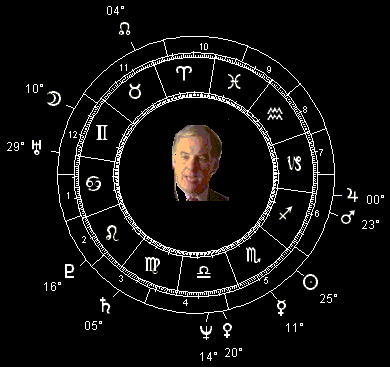 While Clark, Clinton and Dean all show some potential to take the White House back for the Democrats, Dean's chart is the best of the bunch in that regard: Saturn is in trine aspect (120 degree arc) to his natal Sun, and Jupiter trines his natal Moon. These aren't the most impressive indicators in the world. Give me a real planetary alignment, a conjunction or opposition, and you give me confidence. But mere trines are better than nothing, which is all the President has going for him in the way of favorable transits to his natal chart on Election Day. All things considered, if it comes down to Bush versus any of these three, a Bush loss is a possibility. And if it's Bush versus Dean in particular, then you've got yourself a horse race.
While Clark, Clinton and Dean all show some potential to take the White House back for the Democrats, Dean's chart is the best of the bunch in that regard: Saturn is in trine aspect (120 degree arc) to his natal Sun, and Jupiter trines his natal Moon. These aren't the most impressive indicators in the world. Give me a real planetary alignment, a conjunction or opposition, and you give me confidence. But mere trines are better than nothing, which is all the President has going for him in the way of favorable transits to his natal chart on Election Day. All things considered, if it comes down to Bush versus any of these three, a Bush loss is a possibility. And if it's Bush versus Dean in particular, then you've got yourself a horse race.
Lest Democrat partisans rejoice prematurely, I have to say that the Democrats are reduced to hoping for disaster's help in their campaign to take back the White House. Nothing makes an incumbent President vulnerable like bad news for the economy, and Americans in danger overseas. Things have to go badly for America at this point, for the election to go well for the Democrats.
In that regard, the signs of economic recovery that arose late in 2003 appear to parallel the Saturn retrograde that began in October that year and ends in March 2004. By that measure, the recovery appears vulnerable and short-term. By March, consumer confidence starts to look shaky. By May, commodity price hikes and upward pressure on interest rates (associated with a weaker dollar) further threaten the recovery. Saturn's transit through Cancer, a sign of a weakening dollar and a sagging real estate market, won't help. By June, as Saturn transits over the Sun's position in Bush's natal chart as well as in the horoscope for the US Declaration of Independence, a general loss of confidence in the nation's leadership and its economic vitality is likely to be widespread. By the time Election Day rolls around, the state of the American economy might not be strong enough on its own to pull the President through. The one caveat is that rather miraculous Venus transit across the Sun, which could signal a temporary reprieve in economic conditions. If America goes into November feeling the economy is improving, the President is practically guaranteed a win. None of his potential opponents has transits good enough to stem that tide.
As for Americans in danger overseas, the war I predicted for 2003 came through on schedule. Now that the hounds of war have been loosed, it takes awhile to gather them all in again. While 2004 lacks the huge Mars factors and the Jupiter-Neptune opposition which were the signs of war in 2003, unwinding that much martial momentum and ideological confrontation isn't done in a month or even a year. And in any case there are a few echoes of those celestial factors that rear their heads in 2004 - they're more subdued in comparison, to be sure, but they're quite enough to suggest that no widespread outbreak of peace and love is imminent. The upshot is that Iraq and Afghanistan won't be pacified in time to permit the President to relax and bask in the glow of victory. Terror attacks aimed at driving the US out of the liberated Islamic states will continue, although the general Venus cycle makes diminishing resistance seem possible. And it this diminution comes to pass, as it appears it will, then there's another definite plus for the President.
Looking at the horoscopes of the contenders based on the data available to me, it all adds up to another close election in terms of the popular vote, although the electoral totals won't be so close. The winner, if President Bush faces off against Senator Clinton or General Clark: Bush. If his opponent is Governor Dean, it's a toss-up . . . with the edge to Bush because the GOP chart presages the Republicans getting out their vote better.
ACKNOWLEDGMENTS: All astrological charts as well as eclipse and astro-locality maps were calculated and produced using Matrix Software's WinStar.
